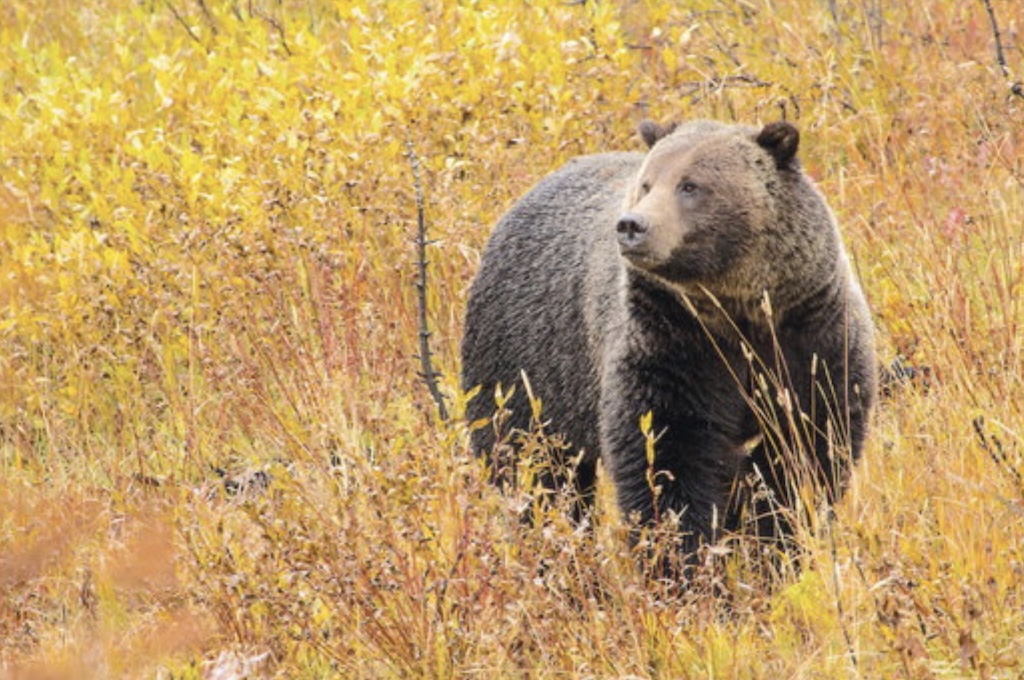Hageman bill to remove grizzlies from ESL advances
By Wyoming News Exchange
July 24, 2025

A grizzly bear wanders through fall foliage in the Greater Yellowstone region. Photo courtesy of C.J. Adams, National Park Service.
By Noah Zahn
Wyoming Tribune Eagle
Via- Wyoming News Exchange
CHEYENNE — A U.S. House committee narrowly approved Wyoming Rep. Harriet Hageman’s push to remove grizzly bears from the endangered species list in the Yellowstone area, despite opposition from activists and potential legal battles.
If given final approval, the bill would reissue a 2017 rule from the first Trump administration when the U.S. Fish and Wildlife Service removed this population of grizzlies from the list.
However, that decision was overturned by a federal circuit court in 2020, and the USFWS changed its position to recommend the species stay on the list and under federal protection.
The agency maintains that position, publishing a report in January recommending the species remain on the list following petitions to delist grizzlies in the Greater Yellowstone Ecosystem and the Northern Continental Divide Ecosystem in Wyoming and Montana, respectively.
Hageman’s proposed legislation, House Resolution 281, would also require the move not to be subject to judicial review.
Her motives for the bill are to showcase a “success story” of the Endangered Species Act of 1973, and save state funding, she said.
“Since a mere 3% of species listed under the ESA have ever been delisted, the ESA desperately needs a success story like the grizzly bear,” she said. “The grizzly is, in fact, the poster child for how the ESA has failed in terms of what it was intended to do and how it has actually been implemented.”
At a House Natural Resources Committee hearing last Tuesday, Hageman argued that the USFWS rejected Wyoming’s petition to delist grizzlies in the GYE not because the species isn’t recovered, but to “move the goal post” to link the GYE delisting to the recovery of other bear populations outside of Wyoming.
The congresswoman alleged this is not only unfair, but illegal.
“To put it bluntly, the ESA has become a zoning mechanism whereby the health and well-being of a species is secondary to environmental groups’ desire to control vast swaths of land and water, and the grizzly is no exception,” she said.
The grizzly bear was listed as a threatened species under the ESA in 1975, when there was an estimated record low of 150 to 200 bears in the Greater Yellowstone Ecosystem.
Last year, USFWS estimated there are now 1,030 bears living in the area, which covers all of Yellowstone National Park and additional portions of Idaho, Montana and Wyoming.
By the end of the 20th century, USFWS and other groups determined that the population had recovered and should be moved toward delisting. A conservation strategy plan was released in 2007 and the species delisted, but the delisting was overturned by a federal district court in 2009 after pushback from several conservation groups.
Hageman said the species has been recovered for decades and argues the Wyoming Grizzly Bear Management Plan, first adopted in 2002, has been a success and encourages the federal government to pass control to the states, which she also argued would be better stewards of the species.
“The state of Wyoming is fully capable of immediately implementing (the plan) to protect and maintain a recovered GYE grizzly population. The Wyoming Game and Fish Department is, in other words, more than capable of and prepared to manage this species,” she said.
By 2018, Wyoming had spent $50 million on grizzly bear recovery and management over the past four decades. Hageman said Wyoming, not USFWS, is responsible for the success of the grizzly population recovery.
However, there has already been significant pushback against Hageman’s proposed legislation, both on the action of delisting and the setting of precedent to legislatively delist a species without judicial review.
Conservationists’ response
On July 14, a letter opposing H.R. 281, was signed by more than 50 conservation organizations,
including Wyoming Untrapped, a Wyoming conservation organization promoting trapping reform.
In an interview with the Wyoming Tribune Eagle, the organization’s co-founder, Lisa Robertson, outlined several reasons why her organization opposes the legislation. Some include that the decisions are dominated by hunting and agricultural needs, which do not result in a positive outlook for grizzlies; the policies are politically motivated; and the animals have intrinsic value.
The letter she signed with 49 other signatories calls Hageman’s bill damaging to the ESA and details how the 2017 delisting rule was already held unlawful by the U.S. Court of Appeals for the Ninth Circuit.
The district court found that USFWS had not sufficiently assessed the effect of delisting the GYE population on the recovery of grizzlies in the rest of the lower 48 states, that USFWS and states had not committed to recalibrate potential new population estimators in the future and that USFWS had inadequately analyzed the genetic health of the GYE grizzly population.
A portion of the letter reads, “H.R. 281 attempts to override the careful scientific and regulatory review of the GYE grizzly bear status, superimposing Congress’s political judgment for science and undercutting decades of work toward restoration. By barring judicial review, it also disregards and precludes the vital check and balance that the courts provide to ensure that agency decisions properly consider the best available science and comport with the law.”
During the House Natural Resources Committee hearing last week, Democrats proposed three amendments to the bill.
The first would require the U.S. Department of the Interior to follow the USFWS 2025 species assessment that all grizzlies in the lower 48 be considered a single population and not separated by restoration region. The second would require more tribal consultation in grizzly management decisions. A third amendment would strip H.R. 281 of the language prohibiting judicial review of the decision.
When discussing the first amendment, Hageman said “activist judges have blocked our efforts to do so (delist). As a result, it is time for Congress to act to carry out the intent of the Endangered Species Act.”
Rep. Jared Huffman, D-Calif., the committee’s ranking member, proposed the third amendment, stating that barring judicial review oversteps a system of checks and balances.
“Access to courts for tribes and a whole bunch of other stakeholders actually helps ensure that the USFWS does its job under the ESA,” he said.
All three amendments failed on party-line votes.
The bill narrowly passed the committee by a vote of 20-19, with elected officials also voting by party line, to recommend approval from the full House of Representatives.
Sen. Cynthia Lummis, R-Wyo., filed a similar bill in January, titled the Grizzly Bear State Management Act of 2025, that proposes to remove grizzly bears from the ESA list and also calls for no judicial review. It has been read twice and referred to the Committee on Environment and Public Works.

